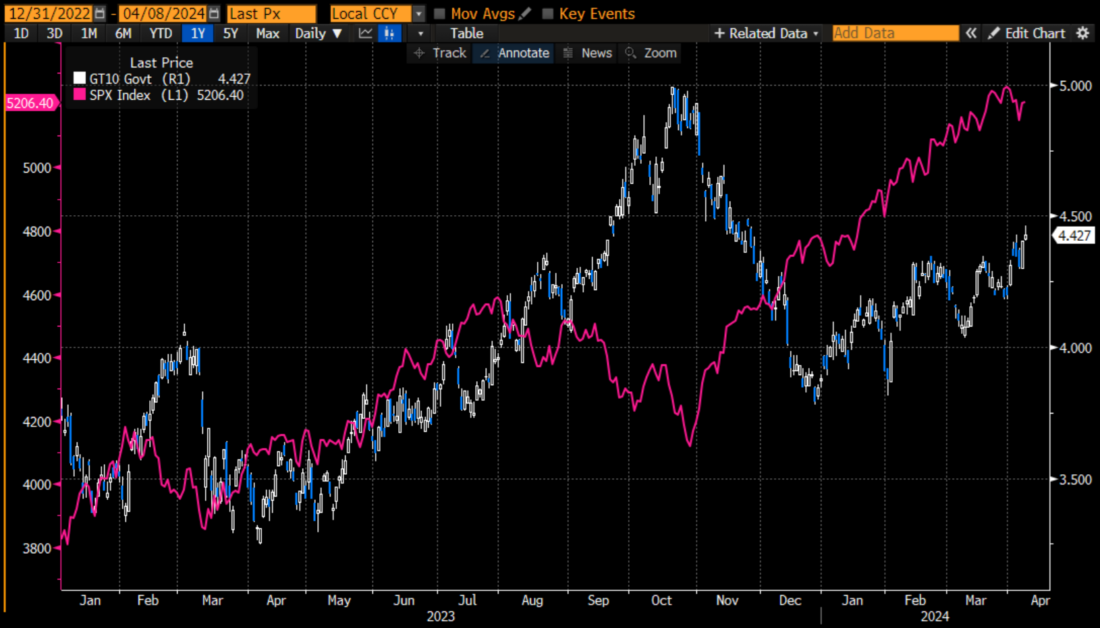OK, I’m guilty. With so many Americans and national media focused on today’s total solar eclipse (I get 91%, not totality in my part of Connecticut), I couldn’t resist using the term in a headline.
What’s worse, when comparing the relative sizes and importance of the bond and stock markets, a lunar eclipse may be the more appropriate analogy. With apologies to Copernicus (and hyper-sensitive stock traders), I believe that the stock market revolves around the bond market. Stretching the astrophysical analogy, consider which asset class has the stronger gravitational pull on the other. It’s common to hear about the effects of higher or lower yields on stocks, but quite rare to hear how stocks affect government bond yields (though they can and do impact high-yield corporates).
But, just as a ship with a powerful enough motor can overcome the effects of the tides, the stock market can, and often does, fight the tides of rising interest rates. This is evident from the chart below, which graphs 10-year benchmark bond yields versus the S&P 500 Index (SPX):
Chart Since the End of 2022, 10-year Yields (white/blue daily candles, right scale) vs. SPX (magenta line, left scale)

Source: Interactive Brokers
We see in the chart above that except for the banking crisis of early 2023, stocks rose along with bond yields until the end of July. At that point, rates began to rise convincingly above the 4% level, and stocks began to suffer. The worst of the equity and bond price declines occurred during the September-October period, when 10-year yields moved rapidly toward 5%; the stock market recovery began at the start of November, when it became clear that bond yields had topped out and stocks moved rapidly higher as yields plummeted toward 3.80% in just two months.
Bear in mind that yields can rise for reasons that are beneficial to stocks. If the economy is improving, that impacts bonds negatively (remember: yields rise when prices go down and vice versa), but is a clear positive for stocks. Also, during a flight to quality, stocks plunge along with yields. The latter is what occurred in March 2023, the former is what is occurring now. The economy is proving more resilient than expected, which clearly benefits stocks at the expense of bonds.
Yet throughout 2024 so far, we have seen stocks continue their advance even as bond yields have steadily risen. We now see 10-year yields topping 4.42%, well above the level that began to cause trouble last year. Can this persist? Maybe. Should it persist? That’s a more difficult question.
Remember, most stock valuation models use some form of discounting future values, whether dividends, earnings, cash flows, or some combination thereof. Those flows are discounted either for the very long-term or even perpetuity. That leads some investors to think of stocks as the ultimate long-duration assets. Contrast that with fixed income, where the time to maturity is finite. A two-year note matures in two years. Stocks don’t have a maturity date.[i] Thus, if relatively long-duration[ii] bond yields rise, in theory, that should negatively impact the future value of a company’s cash flows, thereby impacting its stock price. But honestly, do you really believe that traders, let alone long-term investors, consider that relationship on a daily basis? Of course not – especially in a market that is driven by momentum.
The problem of course is determining when equity investors begin to pay attention to rising bond yields. What we saw last year was that they only did so once stocks began to move sideways during the July-August period. The year’s early momentum was broken, leaving stocks susceptible when yields spiked higher. So far this month, we’ve seen stocks’ advance pause, but it is far too soon to say that the uptrend has lost steam, let alone be broken. That could occur later this month, during earnings season, or next, if “sell in May and go away” takes hold. Or not. It’s not a hard and fast relationship. But when stocks eventually take a sustained break from rising on a daily basis – it’s hard to imagine they won’t, unless you expect a 40% rise in SPX this year – it is difficult to assume that equity investors will continue to ignore rising bond yields. I can’t say when, or even IF stocks will take notice of rising yields. But it would be foolhardy to ignore the likelihood that they could.
(P.S. – Go Huskies! The NCAA Championship is also big news here in Connecticut today.)
—
[i] Old joke: “What’s the difference between bonds and bond traders?” “Bonds eventually mature.”
[ii] Duration and time to maturity are related, but not the same thing. For a better explanation, see How Can You Measure Risk in Treasuries? | Trading Lesson | Traders’ Academy | IBKR Campus.
Join The Conversation
If you have a general question, it may already be covered in our FAQs. If you have an account-specific question or concern, please reach out to Client Services.
Leave a Reply
Disclosure: Interactive Brokers
The analysis in this material is provided for information only and is not and should not be construed as an offer to sell or the solicitation of an offer to buy any security. To the extent that this material discusses general market activity, industry or sector trends or other broad-based economic or political conditions, it should not be construed as research or investment advice. To the extent that it includes references to specific securities, commodities, currencies, or other instruments, those references do not constitute a recommendation by IBKR to buy, sell or hold such investments. This material does not and is not intended to take into account the particular financial conditions, investment objectives or requirements of individual customers. Before acting on this material, you should consider whether it is suitable for your particular circumstances and, as necessary, seek professional advice.
The views and opinions expressed herein are those of the author and do not necessarily reflect the views of Interactive Brokers, its affiliates, or its employees.































In recognition of the above, please enhance functionality of the IBKR Online Portal to include more precise constraints under the Research/Bond Markets page. For example, enhanced functionality will enable users who rely on the portal to search for bonds based in callable/non-capable. And, a field restricting the search to volume based on min principle to be invested – this is key to avoid placing an order to purchase at Xm and having only Yk placed. I have had this happen multiple times and raised it with your help desk, to no avail.
Hello, thank you for reaching out. We have passed your feedback to the appropriate team.